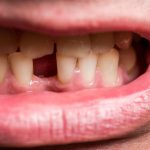Oral and maxillofacial surgery specialists have extensive expertise treating a multitude of oral and dental pathologies. One of the many treatments they can perform is impacted canine exposure, a procedure that is less well-known to the general public.
What is impacted canine exposure? What are impacted teeth, and why do they need to be exposed? Find out in this article.
What is an impacted tooth?
An impacted tooth is a tooth that fails to erupt through the gums and remains stuck in the jawbone. Wisdom teeth are most often affected by this problem, which is one of the reasons why they are usually removed. However, the problem can affect any tooth, depending on the patient’s oral anatomy.
Impacted teeth can have a variety of causes. One of the most common is a lack of space in the mouth. When baby teeth are slow to fall out, the adult teeth have no room to come in. Adult teeth may also deviate from their eruption path if the corresponding baby tooth has sustained an impact or trauma.
Health risks associated with impacted canines
Canines are strong teeth that form the cornerstone of a person’s dentition. They play a vital role in bite alignment and chewing in general.
Oral and maxillofacial surgery clinics frequently see patients with impacted canines. Not including wisdom teeth, canines are the last teeth to come in and are the most commonly impacted. If they fail to erupt, they will usually need to be exposed.
It’s important to undergo this oral surgery if it is deemed necessary by an oral healthcare professional, because there are significant risks associated with impacted canines that remain untreated.
Here are a few of the problems that impacted canines can cause.
- Pericoronitis: Pericoronitis is a gum infection that causes inflammation around the impacted tooth. The infection can spread through the mouth if left untreated.
- Oral pathologies: Impacted teeth significantly increase a patient’s risk of developing cysts, soft tissue lesions and bone lesions that can cause the jawbone to deteriorate over time.
- Cavities: Impacted and partially impacted teeth are more likely to develop cavities.
How are impacted canines exposed?
Patients usually need help from a maxillofacial surgeon to avoid the complications and consequences of an impacted tooth. The surgeon will expose the impacted canine to help it erupt.
Treating impacted canines generally requires both an orthodontist and a maxillofacial surgeon. Regardless of the technique used, these two professionals must communicate and work together to correct the problem.
There are a few different techniques used to expose impacted canines. The surgeon chooses the one that best suits the patient’s situation and the tooth’s position in the gum.
Here is a brief description of the main techniques.
Closed exposure
Closed exposure is the technique that is most commonly used in Quebec. It involves making a small incision in the gum to expose the impacted tooth. Once the tooth is exposed, a metal chain is affixed to the tooth. The incision is then closed with stitches in a way that leaves room for the chain to emerge from the mucosa.
The chain is then attached to an orthodontic appliance in order to correct the tooth’s path. With time and orthodontic follow-up, the tooth will eventually erupt fully and move into the correct position in the mouth.
Open exposure
The open exposure technique differs from closed exposure in a few ways. First, the maxillofacial surgeon creates an incision in the gum to expose the canine, but instead of attaching a chain or appliance to the tooth, the soft tissue surrounding it is removed to leave it exposed.
Then, the surgeon and orthodontist will work together to determine whether it’s best to leave the tooth to come in naturally or use orthodontic treatment to help it into the correct position.
Impacted canine exposure at Clinique MFML
Impacted canine exposure is an important surgical procedure that prevents the negative effects of impacted teeth. The procedure is usually performed in conjunction with orthodontic treatment to ensure that the tooth moves into the correct position in the mouth.
For effective, patient-centred oral surgery services, make an appointment at our clinic in Montreal or on the South Shore.
Are you an orthodontist with a patient you’d like to refer to Clinique MFML for impacted canine exposure? Fill out the referral form available on our website and send it to us!




